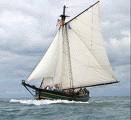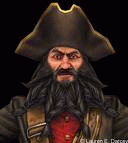|
Welcome to Our Bermuda Trivia Page!Trivia is often described or classified as obscure facts, and a lot of Bermuda's history, although having a major effect on world affairs during the development of the "New World" during the 17th, 18th, and 19th centuries, and even today, both economically and socially as well as politically, are unknown to those who's own histories were and are affected and shaped by events in "The Bermudas". This tiny group of islands situated 600 miles off the coast of America, founded and developed as a corporation rather than a country, has exerted in the past, and still does today, a major influence on its much larger neighbors and friends around the world. I've included many of those events and lots of other trivia about Bermuda on this page. There's Fun Facts and Trivia about Bermuda, and also Historical Facts and Trivia as well. I hope you find them both enlightening and entertaining, and that they add to your personal collection of obscure, albeit interesting, information! Fun Facts and Trivia about Bermuda! TRIVIA - Bermuda Shorts Year round in Bermuda you can see people, mostly men, from all walks of life, dressed in what has become the National dress of Bermuda, Bermuda shorts. From politicians to painters, from techies to tourist's, knobby kneecaps are paraded about for all to admire. Bermuda Shorts are a particular type of short trousers, now widely worn as casual attire by both men and women. The hem can be cuffed or un-cuffed, around one inch above the knee. They are so-named because of their popularity in Bermuda where they are considered appropriate business attire for men when made of suit-like material and worn with knee-length socks, a dress shirt, tie, and a blazer usually adorned with the Bermuda Crest. They are available in a variety of colors, including many pastel shades as well as darker shades for formal occassions. They originated with the British Army for wear in tropical and desert climates, and are still worn by the Royal Navy today. True Bermuda shorts are not to be confused with "clam diggers" or "capri pants" extending below the knee. Cargo shorts may be a similar length, but are typically baggy or less "tailored" than Bermuda shorts. TRIVIA - Bermuda Grass The name "Bermuda Grass" derives from its abundance as an invasive species on Bermuda; it does not occur naturally there. It is believed Bermuda Grass seed was both swept to the island from Africa by tropical winds, and brought to the island by slaves and traders who arrived carrying the seed. A bit of unknown trivia is that locals actually call it "Crab Grass" due to the fact that its deep root system, which can grow to over 2 metres deep, makes it very difficult to extract from the soil, and that it grows very quickly, "crawling" over the surface to form a dense mat. It is fast growing and tough, making it popular and useful for sports fields, especially golf courses, as when damaged it will recover quickly. It is a highly desirable turf grass in warm temperate climates, particularly for those regions where its heat and drought tolerance enable it to survive where few other grasses do.

TRIVIA - Bermuda Sloop The Bermuda sloop is a type of fore-and-aft rigged sailing vessel developed in Bermuda during the 17th century. In its purest form, it is single-masted, although ships with such rigging were built with as many as three masts. Its original form had gaff rigging, but evolved to use what is now known as Bermuda rig, making it the basis of nearly all modern sailing yachts. Although the Bermuda sloop is often described as a development of the narrower-beamed Jamaica sloop, which dates from the 1670s, the high, raked masts and triangular sails of the Bermuda rig are rooted in a tradition of Bermudian boat design dating from the earliest decades of the 17th Century. The development of the rig is thought to have begun with fore-and-aft rigged boats built by a Dutch boat builder, one of the crew of a Dutch frigate which had been wrecked on Bermuda, who quickly established a leading position among Bermuda's boat makers (to the resentment of many of his competitors, who were forced to emulate his designs). The Bermuda sloop became the predominant type of sailing vessel both in the Bermudian colony and amongst sloop rigs worldwide as Bermudian traders visited foreign nations. Soon, shipbuilding became one of the primary trades on the island and ships were exported throughout the English colonies on the American seaboard, and in the West Indies, and eventually to Europe. Bermudians built roughly a thousand ships during the 18th Century. Although many of these were sold abroad, the colony maintained its own large merchant fleet, which, thanks as partly to the domination of trade in many American seaboard ports by branches of wealthy Bermudian families, and partly to the suitability and availability of Bermudian vessels, carried much of the produce exported from the American south to Bermuda and to the West Indies. Bermuda sloop design strongly influenced the development of vessels built by the Chesapeake builders, and Bermudian features like the raked mast began to appear in American schooners. Eventually, Bermuda sloops became the standard advice vessels of the navy, used for communications, reconnoitring, anti-slaving, and anti-smuggling, and other roles to which they were well suited due to their speed and manouverability. The most notable examples of these were HMS Pickle, which raced back to England with news of the British victory and the death of Admiral Lord Nelson at the end of the Battle of Trafalgar (it had also been Bermudian picket boats which had given warning of the enemy fleet), and HMS Whiting, of 79 tons and four guns, which lowered anchor in the harbour of Hampton Roads on 8 July, 1812. She was carrying despatches from Portsmouth, and, while her captain was being rowed ashore, the American privateer Dash, which happened to be leaving port, seized the vessel. The crew of the Whiting had not yet received news of the American declaration of war, and her capture was the first naval action of the American War of 1812.

TRIVIA - Saint Brendan A bit of unknown trivia is that Bermuda was possibly discovered by St.Brendan, an Irish monk whom legend says explored the Atlantic Ocean in the 6th century. One of the legendary accounts of St. Brendan's journeytells of "an isolated island far from any other land, with birds chattering at sunset"". Brendan is said to have sailed in search of a fabled Paradise with a company of monks, the number of which is variously stated as from 18 to 150. After a long voyage of seven years they reached the "Terra Repromissionis", or Paradise, a most beautiful land with luxuriant vegetation. There are many disputes as to whether St. Brendans travels are fact or fable, but it has been proved that navigators possibly did sail across the Atlantic during those times. TRIVIA - Irish and other White Slaves Many people don't know, or choose to ignore this bit of trivia about slavery. After 1684, Bermuda turned wholesale to a maritime economy, and slaves, Black, Amerindian, and Irish played an increasing role in this. The Irish slaves were prisoners taken by Cromwell after his victories over the Irish, or indentured servants who were bound to work a set number of years (7) to pay off their passage. A cruel boss would want to get as much out of his servant as possible during that period, and as a result, indentured servants were often treated worse than slaves, who were considered a lifelong investment.

TRIVIA - Bermudians Rescue of Jamestown Bermuda was first colonized in 1609 by the British when Admiral Sir George Somer's ship The Sea Venture was shipwrecked there during a storm on its way to the new colony of Jamestown, Virginia. A year later, after building 2 new ships, The Deliverance and The Patience, the survivors set out for Jamestown once again. On their arrival, they found the settlement in a terrible state, only around 60 of the over 500 original colonists surviving what had been a ruthless winter. Supplies were almost nil, and instead of finding the help they sought, the original Bermudians became the rescuers of Jamestown. They decided to abandon the colony and sail back to Bermuda via the Grand Banks, where it was hoped they would catch fish enough to see them back to Bermuda. On the very same day, as they were sailing down the river headed out to sea, Lord de la Warr arrived with his fleet of supply ships. The vessels met, and all put back to Jamestown. TRIVIA - Ole Dan Tucker Here's a bit of trivia I bet you didn't know! The Ole Dan Tucker of the famous folk song of the same name was once a Governor of Bermuda. Daniel Tucker was a plantation owner in Virginia who had a reputation of having a strong hand, which was what was needed to motivate those early settlers who had grown lazy. He arrived in Bermuda and literally whipped them into shape, not being afraid to use the lash to enforce his commands, or even to hang for speaking against him. One group who sought to escape his wrath did so by convincing him to let them depart to an isolated area of Bermuda to build him a grand fishing boat that he could use to fish "in good weather, or bad". Ole Dan Tucker agreed and the men cleared off to a distant part of the island and built the boat. When the time came for its unveiling, Governor Tucker found that the men had sailed away in it, and after a long and hazardous journey, they landed in Ireland, 3500 miles away!

TRIVIA - Blackbeard The Pirate's Stronghold One of the world's first pirates was a Bermudian by the name of Henry Jennings who began his career in the early 1700's. He was originally hired by the then Governor of Jamaica, Lord Hamilton, to hunt down pirates. Instead, he and his crew of friends sailed into the Straits of Florida and found salvage ships from Spain busily raising gold from the wrecks of a Spanish convoy that was driven aground by a hurricane in 1714. Jennings and his friends raided one of the salvage camps and loaded their ships with loot, adding more to it when they encountered a Spanish vessel which they also plundered. Jennings suggested they sail to New Providence and establish a base, which became the home port for the likes of Blackbeard (Edward Teach), Charles Vane, Benjamin Hornigold, and Calico Jack Rackham.

TRIVIA - Pocahontas Another historical bit of trivia is that Johne Rolfe, who was to later discover how to cure tobacco and become the husband of the Indian Princess Pocahontas, was one of the original shipwrecked colonists on Bermuda. He arrived on the Sea Venture with his first wife, who gave birth to their daughter (named Bermuda), and who passed away before they rebuilt The Deliverance and The Patience. John Rolfe remained in Virginia after the voyage over to Jamestown.
Back to Homepage from Bermuda Trivia
|



